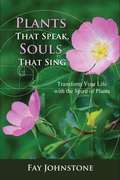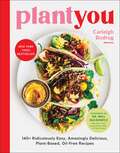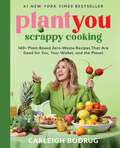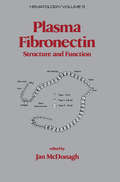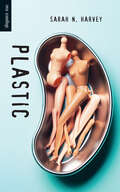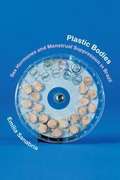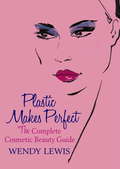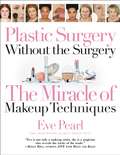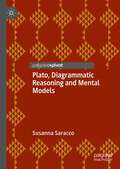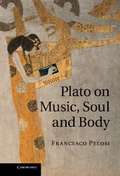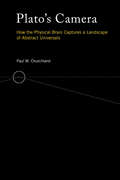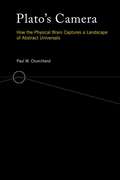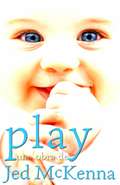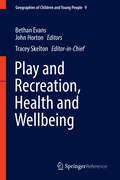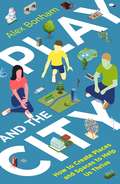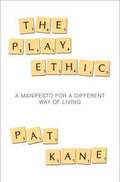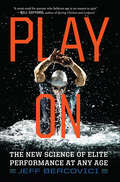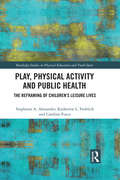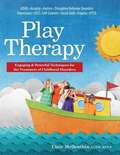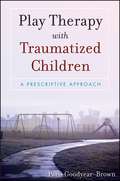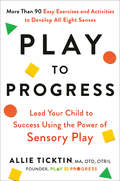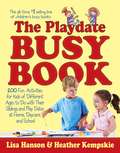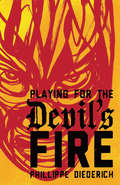- Table View
- List View
Plants That Speak, Souls That Sing: Transform Your Life with the Spirit of Plants
by Fay JohnstoneEngage with the intelligence of nature to discover your unique role and deepen your spiritual path on Earth • Presents practical ways to rekindle your connection with nature and open up to plant consciousness as a way to enrich your spiritual path • Offers guidance on how to meet plant allies with wisdom teachings specific to you and your path • Provides over 40 exercises, including shamanic journeys, as well as links to digital downloads for a shamanic drumming track and guided meditations As our lives become more absorbed in screen time rather than the great outdoors, it feels essential to open up our senses again to the riches of nature, reestablishing our connection with the heartbeat of the Earth. In this book, Fay Johnstone provides a road map for bridging the gap between plants and people, allowing our sacred relationship with the Green Kingdom to be restored. Fay shows how to confidently meet, explore, and build relationships with key plant allies to enjoy a more balanced connection with yourself and your environment. Sharing her passion for the plant world, she provides a practical guide to rekindling your connection with nature, opening up to plant consciousness as a way to enrich your path and weave the enchantment of nature back into your own life. She includes more than 40 simple, practical exercises and meditations to guide you on a heart-centered journey of transformation and commune with the environment, the seasons, the cycles of the moon, and the Earth Heart. Addressing plants as conscious beings we meet their spirit, while at the same time aligning with our own true nature and sense of purpose as a creature of this Earth. The book also introduces the shamanic practice of plant spirit healing, emphasizing that ceremony begins at home with our local plants, rather than with the famous plant healers of the Amazon. Guided meditations and shamanic journeys enable a deeper exploration and interaction with the spirit of plants for healing and support. The author offers practical advice on how to initiate a conversation with plants and meet a plant ally with wisdom teachings specific to you and your path. Whether you explore your back garden, office plants, or morning cup of tea, Fay reveals how to introduce the magic of plants into your daily routine and appreciate the important role plants play. Reaching out to interact with nature is a step forward not only on your personal journey to wholeness but also toward healing our Earth.
PlantYou: 140+ Ridiculously Easy, Amazingly Delicious Plant-Based Oil-Free Recipes
by Carleigh BodrugINSTANT NEW YORK TIMES BESTSELLERPlant-based eating doesn't have to be complicated! The delicious recipes in this easy-to-follow cookbook are guaranteed to keep you inspired and motivated.Enter PlantYou, the ridiculously easy plant-based, oil-free cookbook with over 140+ healthy vegan recipes for breakfast, lunch, dinner, cheese sauces, salad dressings, dessert and more!In her eagerly anticipated debut cookbook, Carleigh Bodrug, the Founder of the wildly popular social media community PlantYou, provides readers with the ultimate full color guidebook that makes plant-based meal planning, grocery shopping and cooking a breeze. With every single recipe, you will find a visual infographic marking the ingredients you need, making it easy to shop, determine portion sizes, and dive into the delicious and nutritious dishes.Get ready for mouthwatering dishes like Chocolate Chip Banana Bread Breakfast Cookies, Best Ever Cauli Wings, and the Big BOSS Burrito that you simply won&’t believe are made from plants. &“An instant kitchen classic…In your quest to find delicious food that also promotes health, both human health and the health of the planet and the animals we share our world with, you&’ve come to the right place.&” —from the foreword by Dr. Will Bulsiewicz
PlantYou: 140+ Plant-Based Zero-Waste Recipes That Are Good for You, Your Wallet, and the Planet
by Carleigh BodrugInstant #1 New York Times BestsellerSave money, reduce food waste, and eat healthier than you ever have before with this highly anticipated cookbook from New York Times bestselling author and social media sensation, Carleigh Bodrug. Spinning off of Bodrug's wildly popular Scrappy Cooking social media series, the cookbook is packed with over 150+ whole-food, plant-based recipes that show the reader how to make the most of the food they have in their fridge and pantry with easy and approachable vegan recipes anyone can make. Transform radish tops into pesto, broccoli stems into summer rolls and wilting greens into smoothie cubes... But that's not all. The book will equip readers with not only the tools to make the most of their scraps, but use up just about any vegetable, grain or bean from their fridge and pantry in the flexible Kitchen Raid Recipes, or cross reference commonly wasted foods like stale bread from a "Got This, Make That" index so these items can be used up in the easiest and most delicious way possible. Scrappy Cooking not only puts the focus on eating a diet that's more conscious for our environment (and our wallets) but our health as well. Every recipe in the book is vegan, almost entirely oil free, and focuses on whole, plant-based foods that are good for our bodies and the planet. Get ready for recipes like The Whole Darn Squash (Pasta), Skillet Lasagna, One Pan Orzo Casserole, Vodka Penne With Broccolini, Whole Roasted Cauliflower with Roasted Red Pepper Sauce, Chickpea Pot Pie, Orange Peel Chickn&’, Loaded Tortilla Bowls, Sheet Pan Tacos with Carrot Top Chimichurri, Rebel &“Ribs&”, Veggie Masala Burgers, Palak &“Paneer&”, Vegan Meaty Hand Pies, We-Got-the-Beet Chips, Pickle-Mania Chips, Cornmeal Biscuits, Bang Bang Broccoli-cious Steaks…and more!
Plasma Fibronectin: Structure and Functions
by Jan McdonaghThis volume deals with a multifunctional plasma and tissue protein, fibronectin, which participates in many significant biological and pathophysiological actions, presenting the information concerning structure and describing the interactions of fibronectin with fibrinogen and fibrin.
Plastic (Orca Soundings)
by Sarah N. HarveyWhen Jack develops an interest in something, he puts his all into it, making lists, doing research and learning all he can. When his best friend Leah decides to have plastic surgery for her sixteenth birthday, Jack is horrified—and then determined to stop her. Researching the surgery and the results, he finds that there are unscrupulous surgeons operating on the very young, and no one does anything about it. Jack organizes a protest and becomes an instant celebrity. But when someone else takes up the cause and the protest turns violent, Jack is forced to make some tough decisions.
Plastic Bodies: Sex Hormones and Menstrual Suppression in Brazil
by Emilia SanabriaIn Plastic Bodies Emilia Sanabria examines how sex hormones are enrolled to create, mold, and discipline social relations and subjectivities. She shows how hormones have become central to contemporary understandings of the body, class, gender, sex, personhood, modernity, and Brazilian national identity. Through interviews with women and doctors; observations in clinics, research centers and pharmacies; and analyses of contraceptive marketing, Sanabria traces the genealogy of menstrual suppression, from its use in population control strategies in the global South to its remarketing as a practice of pharmaceutical self-enhancement couched in neoliberal notions of choice. She links the widespread practice of menstrual suppression and other related elective medical interventions to Bahian views of the body as a malleable object that requires constant work. Given this bodily plasticity, and its potentially limitless character, the book considers ways to assess the values attributed to bodily interventions. Plastic Bodies will be of interest to all those working in medical anthropology, gender studies, and sexual and reproductive health.
Plastic Makes Perfect: The Complete Cosmetic Beauty Guide
by Wendy LewisThe must-have guide to cosmetic surgery written by the world's leading independent consultant.Cosmetic surgery, once the preserve of the jet-setting rich, is now something more people than ever are prepared to consider, and the industry is worth almost £700 million in the UK alone. But what is involved, what are the risks and how much does it cost?This comprehensive guide by one of the world's leading experts outlines all the latest surgical procedures and non-invasive treatments and gives the facts you need to make an informed decision on whether it is right for you. Giving the reader the low down on the most popular cosmetic surgical procedures and the non-surgical alternatives, Wendy provides details on the very latest techniques and procedures, the questions to ask, the resources to help you find the best doctors, hints on speeding post-op recovery and the ways to negotiate potential pitfalls.Deciding to have a cosmetic procedure is a very personal journey to embark on. PLASTIC MAKES PERFECT is filled with expert but friendly advice on one of the most important life-altering decisions we can make.
Plastic Makes Perfect: The Complete Cosmetic Beauty Guide
by Wendy LewisCosmetic surgery, once the preserve of the jet-setting rich, is now something more people than ever are prepared to consider, and the industry is worth almost £700 million in the UK alone. But what is involved, what are the risks and how much does it cost?This comprehensive guide by one of the world's leading experts outlines all the latest surgical procedures and non-invasive treatments and gives the facts you need to make an informed decision on whether it is right for you. Giving the reader the low down on the most popular cosmetic surgical procedures and the non-surgical alternatives, Wendy provides details on the very latest techniques and procedures, the questions to ask, the resources to help you find the best doctors, hints on speeding post-op recovery and the ways to negotiate potential pitfalls.Deciding to have a cosmetic procedure is a very personal journey to embark on. PLASTIC MAKES PERFECT is filled with expert but friendly advice on one of the most important life-altering decisions we can make.
Plastic Surgery Without the Surgery: The Miracle of Makeup Techniques
by Eve PearlAn Emmy Award-winning celebrity makeup artist presents a practical guide that reveals proven makeup techniques to correct flaws-without going under the knife. Many people would love to change some part of their bodies. In fact, they spend millions of dollars on products and undergo risky, expensive surgery in the hopes of improving their looks. Plastic Surgery Without The Surgery is a new kind of makeup book that demonstrates how readers can accentuate their features and correct flaws-easily and inexpensively-using proven makeup techniques. With easy-to-follow, professional secrets and four-color photos throughout, Eve Pearl, the Emmy Award-winning makeup artist from ABC's The View, teaches readers to lift their eyes, enlarge their breasts, plump their lips, reduce their nose size, and much more. From eyelift to facelift, readers will be amazed at the results-without the pain, the risk, or the cost of surgery!
Plato, Diagrammatic Reasoning and Mental Models
by Susanna SaraccoThis book analyses the role of diagrammatic reasoning in Plato’s philosophy: the readers will realize that Plato, describing the stages of human cognitive development using a diagram, poses a logic problem to stimulate the general reasoning abilities of his readers. Following the examination of mental models in this book, the readers will reflect on what inferences can be useful to approach this kind of logic problem. Plato calls for a collaboration between writer and readers. In this book the readers will examine the connection between diagrams and discovery, realizing the important epistemic role of visualization. They will recognize the crucial role that diagrams play in problem solving. The logic problem elaborated by Plato is addressed considering the epistemic function of mental models. These models introduce to an advanced stage of cognitive development, in which reasoning uses in its investigations a higher-level of mathematical complexity, represented by structuralism.
Plato on Music, Soul and Body
by Francesco PelosiPlato's reflection on the relationship between soul and body has attracted scholars' attention since antiquity. Less noted, but worthy of consideration, is Plato's thought on music and its effects on human beings. This book adopts an innovative approach towards analysing the soul-body problem by uncovering and emphasising the philosophical value of Plato's treatment of the phenomenon of music. By investigating in detail how Plato conceives of the musical experience and its influence on intelligence, passions and perceptions, it illuminates the intersection of cognitive and emotional functions in Plato's philosophy of mind.
Plato's Camera: How the Physical Brain Captures a Landscape of Abstract Universals (The\mit Press Ser.)
by Paul M. ChurchlandA noted philosopher draws on the empirical results and conceptual resources of cognitive neuroscience to address questions about the nature of knowledge. In Plato's Camera, eminent philosopher Paul Churchland offers a novel account of how the brain constructs a representation—or "takes a picture"—of the universe's timeless categorical and dynamical structure. This construction process, which begins at birth, yields the enduring background conceptual framework with which we will interpret our sensory experience for the rest of our lives. But, as even Plato knew, to make singular perceptual judgments requires that we possess an antecedent framework of abstract categories to which any perceived particular can be relevantly assimilated. How that background framework is assembled in the first place is the motivating mystery, and the primary target, of Churchland's book. Unexpectedly, this neurobiologically grounded account of human cognition also provides a systematic story of how such low-level epistemological activities are integrated within an enveloping framework of linguistic structures and regulatory mechanisms at the social level. As Churchland illustrates, this integration of cognitive mechanisms at several levels has launched the human race on an epistemological adventure denied to all other terrestrial creatures.
Plato's Camera: How the Physical Brain Captures a Landscape of Abstract Universals
by Paul M. ChurchlandIn Plato's Camera, eminent philosopher Paul Churchland offers a novel account of how the brain constructs a representation--or 'takes a picture'--of the universe's timeless categorical and dynamical structure. This construction process, which begins at birth, yields the enduring background conceptual framework with which we will interpret our sensory experience for the rest of our lives. But, as even Plato knew, to make singular perceptual judgments requires that we possess an antecedent framework of abstract categories to which any perceived particular can be relevantly assimilated. How that background framework is assembled in the first place is the motivating mystery, and the primary target, of Churchland's book. His account draws on the best of the recent philosophical literature on semantic theory, and on the most recent results from cognitive neurobiology. The resulting story throws immediate light on issues that have been at the center of philosophy for at least two millennia, such as how the mind represents reality, both in its ephemeral and in its timeless dimensions. Unexpectedly, this neurobiologically grounded account of human cognition also provides a systematic story of how such low-level epistemological activities are integrated within an enveloping framework of linguistic structures and regulatory mechanisms at the social level. As Churchland illustrates, this integration of cognitive mechanisms at several levels has launched the human race on an epistemological adventure denied to all other terrestrial creatures.
Play: una obra de Jed McKenna
by Jed Mckenna Noelia Jiménez DíazDescripción del libro: Es lo que es, según dicen, pero... ¿lo es? Jed McKenna ha sido siempre más de destruir preguntas que de responderlas, de modo que no es de extrañar que Play tenga más preguntas que respuestas. De hecho, podría verse como una progresión a través de las etapas de la autoindagación, en la que cada una de las siete escenas nos lleva un poco más lejos en el viaje hacie el interior; las primeras escenas plantean las preguntas y las últimas se fijan en aquellos que hacen las preguntas, mostrándonos, prometiéndonos, advirtiéndonos, a dónde lleva realmente la indagación honesta e implacable. Pero, ¿quién –plantea Jed-- quiere ir realmente a dónde lleva este camino? En este viaje, quien uno es cambia a cada paso, y dar el siguiente paso es lo importante. Al final, Play es lo que es. ¿O no...? Tal vez es el viaje de la vida examinada o tal vez no es más que una obrita juguetona. Por supuesto, en última instancia, Play, igual que la vida, igual que cualquier cosa, es lo que quiera que sea para usted.
Play and Recreation, Health and Wellbeing
by Bethan Evans John Horton Tracey SkeltonGeographies of children and young people is a rapidly emerging sub-discipline within human geography. There is now a critical mass of established academic work, key names within academia, growing numbers of graduate students and expanding numbers of university level taught courses. There are also professional training programmes at national scales and in international contexts that work specifically with children and young people. In addition to a productive journal of Children's Geographies, there's a range of monographs, textbooks and edited collections focusing on children and young people published by all the major academic presses then there is a substantive body of work on younger people within human geography and active authors and researchers working within international contexts to warrant a specific Major Reference Work on children's and young people's geographies. The volumes and sections are structured by themes, which then reflect the broader geographical locations of the research.
Play and the City: How to Create Places and Spaces To Help Us Thrive
by Alex BonhamPlay is essential, for children but also adults. It's how we relax and revitalise ourselves, build and maintain friendships, try new things, learn and innovate.Cities have always been sites of play, bringing people together and pushing the boundaries of what is humanly possible. And now we need our cities to encourage and facilitate play of all kinds more than ever. If we want a world for our children to play in, we need to have a go at doing things differently. A city that is enjoyable to live in - that provides welcoming spaces, plentiful resources, and an attitude of 'yes, you can' - is a playful city. A city that is good for eight-year-olds as well as eighty-year-olds is a city that's good for all of us. By looking at how different cities across space and time have sought to encourage and facilitate play, Bonham shows us how to conceptualise our own contemporary city as a game, and encourages us to become participants rather than spectators.Play the city! Get involved, make a difference and help to bring your city back to life. There is help here to identify opportunities, build a team of friends and allies, take part - and win! It's time to make your move.
Play and the City: How to Create Places and Spaces To Help Us Thrive
by Alex BonhamPlay is essential, for children but also adults. It's how we relax and revitalise ourselves, build and maintain friendships, try new things, learn and innovate.Cities have always been sites of play, bringing people together and pushing the boundaries of what is humanly possible. And now we need our cities to encourage and facilitate play of all kinds more than ever. If we want a world for our children to play in, we need to have a go at doing things differently. A city that is enjoyable to live in - that provides welcoming spaces, plentiful resources, and an attitude of 'yes, you can' - is a playful city. A city that is good for eight-year-olds as well as eighty-year-olds is a city that's good for all of us. By looking at how different cities across space and time have sought to encourage and facilitate play, Bonham shows us how to conceptualise our own contemporary city as a game, and encourages us to become participants rather than spectators.Play the city! Get involved, make a difference and help to bring your city back to life. There is help here to identify opportunities, build a team of friends and allies, take part - and win! It's time to make your move.
The Play Ethic: A Manifesto for a Different Way of Living
by Pat KaneThe Play Ethic explores the real meaning of play and shows how a more playful society would revolutionize and liberate our daily lives. Using wide and varied sources from the Enlightenment to Eminem, Socrates to Chaos theory, Kierkegaard to Karaoke, this book shows how play is fundamental to both society and to the individual, and how the work ethic that has dominated the last three centuries is ill-equipped to deal with the modern world.
Play On: The New Science of Elite Performance at Any Age
by Jeff BercoviciA lively, deeply reported tour of the science and strategies helping athletes like Tom Brady, Serena Williams, Carli Lloyd, and LeBron James redefine the notion of &“peak age.&” Season after season, today&’s sports superstars seem to defy the limits of physical aging that inevitably sideline their competitors. How much of the difference is genetic destiny and how much can be attributed to better training, medicine, and technology? Is athletic longevity a skill that can be taught or a mental discipline that can be mastered? Can career-ending injuries be predicted and avoided? Journalist Jeff Bercovici spent extensive time with professional and Olympic athletes, coaches, and doctors to find the answers to these questions. His quest led him to training camps, tournaments, hospitals, antiaging clinics, and Silicon Valley startups, where he tried cutting-edge treatments and technologies firsthand and investigated the realities behind health fads like alkaline diets, high-intensity interval training, and cryotherapy. Through fascinating profiles and first-person anecdotes, Bercovici illuminates the science and strategies extending the careers of elite older athletes, uncovers the latest advances in fields from nutrition to brain science to virtual reality, and offers empowering insights about how the rest of us can find peak performance at any age.
Play, Physical Activity and Public Health: The Reframing of Children's Leisure Lives (Routledge Studies in Physical Education and Youth Sport)
by Stephanie A. Alexander Katherine L. Frohlich Caroline FuscoAre children playing less than they used to? Are rising obesity rates linked to a decline in children’s time to play freely? These and other related questions have filled the pages of newspapers, magazines and scholarly journals for the past decade. Researchers and journalists have attributed these issues to societal changes around children’s lives and leisure, the growth of structured and organised activities and increasing perceptions of risk in children’s play. Play, Physical Activity and Public Health presents a discussion of the way modern notions of play are rendering children’s leisure activities less free and less engaged in simply for fun. Based on original qualitative research, and analysis of contemporary media from Canada and elsewhere, this book argues that the growing health concerns around childhood play entail a paradox: by advocating, promoting, discussing, and re-directing children’s play, a new form of children’s leisure is emerging - one that is purpose-driven, instrumentalised for health, and ultimately, less free. We explore how play has become goal-oriented, a means to health ends, and how the management of pleasure in play as well as diverse risk discourses around play continue to limit and constrain possibilities for children and families to play and engage in leisure freely. Incorporating past critiques of this trend in play, we argue for research and practice to create new possibilities and ways of thinking about children's play, leisure, fun and childhood, that are less constrained and managed, and importantly less geared towards health goals. This is a valuable resource for students of the sociology of sport, kinesiology, sports and health psychology, education, public health, and childhood studies. It is also an important read for school teachers, public health practitioners, psychologists, physical education teachers, academics and parents interested in how children’s leisure lives are being shaped by the growing and diverse discussions around play.
Play Therapy: Engaging & Powerful Techniques For The Treatment Of Childhood Disorders
by Clair MellenthinDiscover why play therapy works and how to use it to treat childhood mental health challenges such as: ADHD Anxiety Autism Disruptive Behavior Disorders Depression OCD PTSD Trauma Self-Esteem Social Skills Play Therapy is filled with dozens of powerful play techniques adapted for use in individual, family, and group therapy, for schools, and at home. Inside you ll find: Hands on Activities Printable Worksheets Expressive and Creative Arts Dynamic Therapeutic Games Puppet Play Guided Imagery Parent-Child Interventions Tips for Parents & Teachers.
Play Therapy With Traumatized Children: A Prescriptive Approach
by Paris Goodyear-BrownIntroducing a practical model of play therapy for traumatized children Some of the most rewarding work a therapist can do is help a child recover from a traumatic event. But where to begin? A growing body of play therapy literature offers many specific techniques and a variety of theoretical models; however, many therapists are still searching for a comprehensive model of treatment that incorporates solid theoretical constructs with effective play therapy interventions. Clinicians have long recognized that trauma therapy is not just a matter of techniques but a journey with a beginning, middle, and end. In a pioneering contribution to the field, Play Therapy with Traumatized Children: A Prescriptive Approach, the author codifies the process in her model, Flexibly Sequential Play Therapy (FSPT). Integrating non-directive and directive approaches, this components-based model allows for the uniqueness of each child to be valued while providing a safe, systematic journey towards trauma resolution. The FSPT model demystifies play-based trauma treatment by outlining the scope and sequence of posttraumatic play therapy and providing detailed guidance for clinicians at each step of the process. Dramatically demonstrating the process of healing in case histories drawn from fifteen years of clinical practice with traumatized children, Play Therapy with Traumatized Children addresses: -Creating a safe place for trauma processing -Augmenting the child's adaptive coping strategies and soothing his or her physiology -Correcting the child's cognitive distortions -Ensuring that caregivers are facilitative partners in treatment Inviting gradual exposure to trauma content through play -Creating developmentally sensitive trauma narratives -Using termination to make positive meaning of the post-trauma self.
Play to Progress: Lead Your Child to Success Using the Power of Sensory Play
by Allie TicktinA game-changing book on child development--and the importance of physical play--for this digital and screen age.For children to develop to their fullest potential, their sensory system—which, in addition to the big five of sight, hearing, taste, touch, and smell, includes movement and balance (vestibular), body awareness (proprioception), and internal perception (interoception)—needs to be stimulated from the time they are born. Their senses flourish when they explore their environment by touching new textures, including their food, running, jumping, climbing, and splashing outside. As an occupational therapist with a specialty in sensory integration, Allie Ticktin has seen an increase in cases of children who struggle to sit in circle time or at their desk upright and who are delayed in walking, talking, and playing by themselves and with their peers. In the recent past, kids spent their days playing outside and naturally engaging their sensory system and building key developmental skills. But with increasing time pressures for both kids and parents, children are spending more time in front of screens and less time exploring and interacting with their environment. The good news is that boosting your child&’s sensory development doesn&’t take enormous amounts of time or supplies, or any special skills. Here, Ticktin discusses the eight sensory systems and how a child uses them, and offers easy, fun activities—as well as advice on setting up a play area—that will encourage their development so that your little one will be better able to respond to their emotions, build friendships, communicate their needs, and thrive in school. That&’s the power of sensory play.
The Playdate Busy Book
by Heather Kempskie Lisa HansonIn The Playdate Busy Book (previously titled The Siblings' Busy Book) authors Hanson and Kempskie have outlined 200 activities that all the kids can enjoy together (ages 3 months to 9 years). Each activity write-up includes ways for babies, toddlers, preschoolers, and school-age kids to join in the fun. As in other Busy Books, the activities range from arts & crafts, seasonal decorating, outdoor adventures, and imagination stretchers to making music, learning together, and rainy-day family fun.
Playing for the Devil's Fire
by Phillippe Diederich<p>Thirteen-year-old Boli and his friends are deep in the middle of a game of marbles. An older boy named Mosca has won the prized Devil's Fire marble. His pals are jealous and want to win it away from him. <p>This is Izayoc, the place of tears, a small pueblo in a tiny valley west of Mexico City where nothing much happens. It's a typical hot Sunday morning except that on the way to church someone discovers the severed head of Enrique Quintanilla propped on the ledge of one of the cement planters in the plaza and everything changes. <p>Not apocalyptic changes, like phalanxes of men riding on horses with stingers for tails, but subtle ones: poor neighbors turning up with brand-new SUVs, pimpled teens with fancy girls hanging off them. Boli's parents leave for Toluca and don't arrive at their destination. No one will talk about it. <p>A washed out masked wrestler turns up one day, a man only interested in finding his next meal. Boli hopes to inspire the luchador to set out with him to find his parents.</p>
